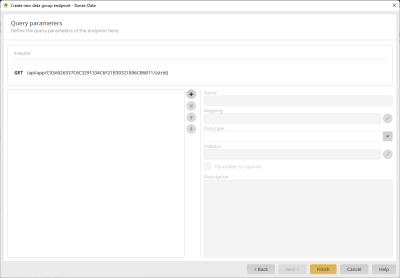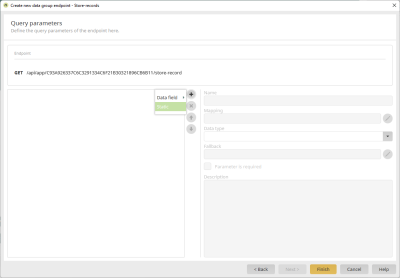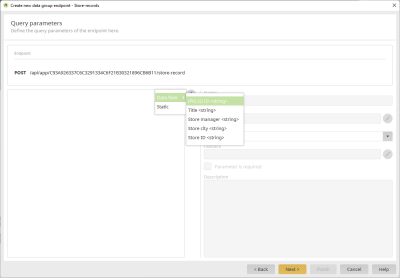Query parameters are defined in the "Query parameters" dialog step.
It is not always necessary to create a query parameter.
Click on ![]() to define a new query parameter.
to define a new query parameter.
Query parameter types
Which query parameter types you can create depends on which action or method you selected in the Data Group Selection dialog step.
Static query parameters
You can always create a static query parameter.
-
Click on "Static".
-
Enter a name in the "Name" field.
The name must be at least two characters long and begin with a lowercase letter. In addition, it must contain only alphanumeric characters and underscores.
Query parameters with data field mapping
Click on "Data field" to create a query parameter with (direct) data field assignment.
Then select the desired data field.
Name
Enter a name for the parameter here.
The name may occur only once in an endpoint.
The name must correspond to the regular expression [a-zA-Z][a-zA-Z\\d-_.]+. In other words, it must be at least two characters long and start with a letter. Only letters, numbers, hyphens, underscores and periods are allowed.
Data type
Select the data type of the path parameter here.
The data type of the incoming path parameter must match the data type selected here. If the data types do not match, the corresponding request is not processed.
Fallback
Here you can store a fallback value for the parameter.
The fallback value is used if the parameter is to be evaluated in any case and at the same time a value for the parameter does not necessarily have to be specified when the end point is called.
Parameter is required
If you activate the checkbox, the parameter for the request must be specified.
Activating the checkbox can be helpful, for example, if a parameter is expected in any case but a sensible fallback cannot be defined (e.g. a user ID).
Description
Enter a description for the parameter here. Multiline texts are possible. The description is part of the Swagger documentation.


